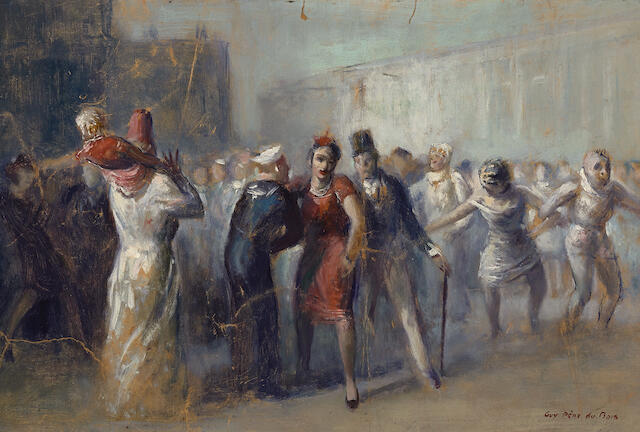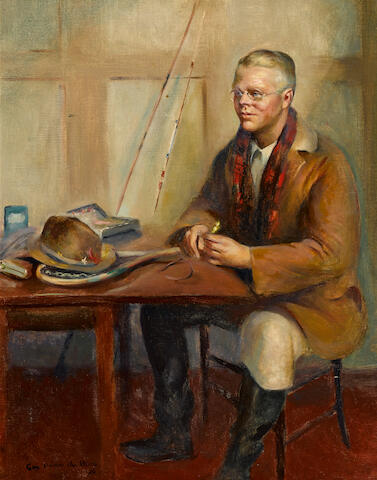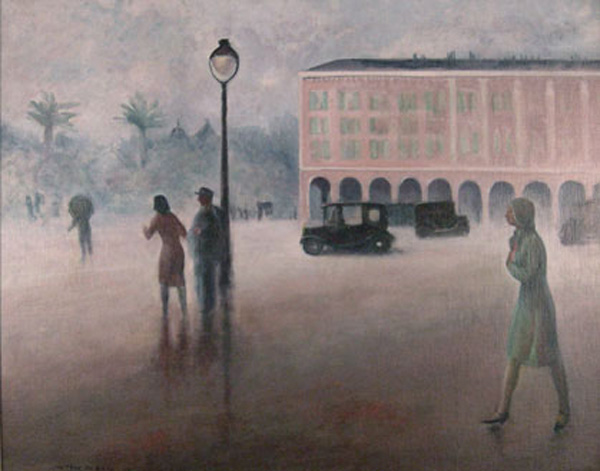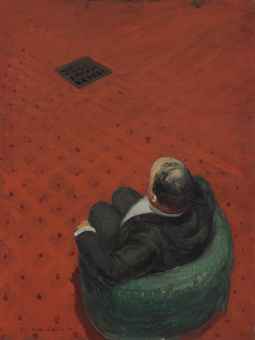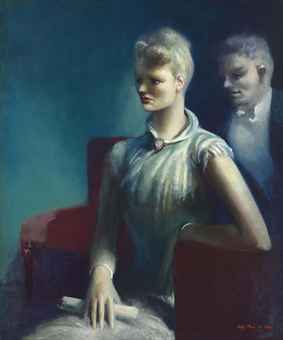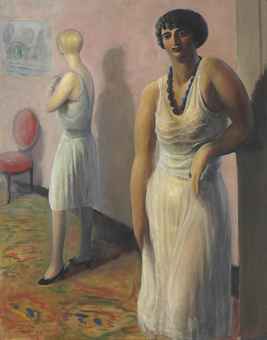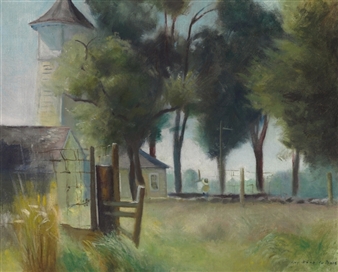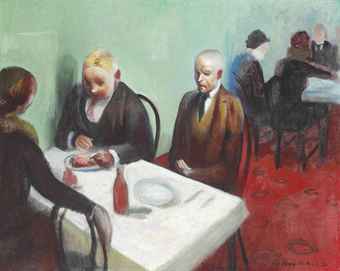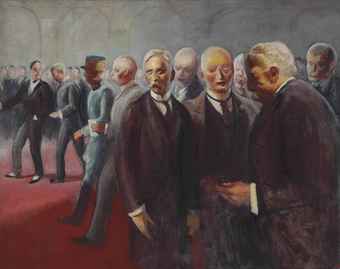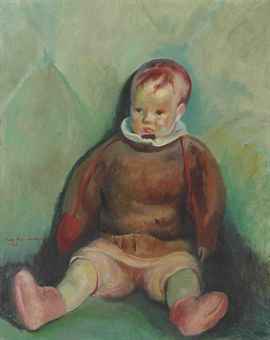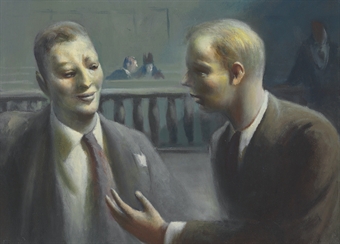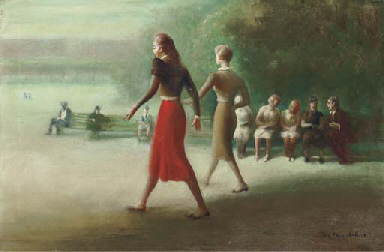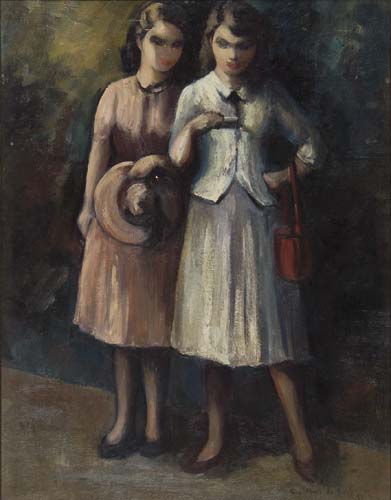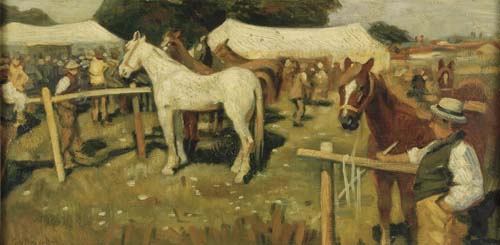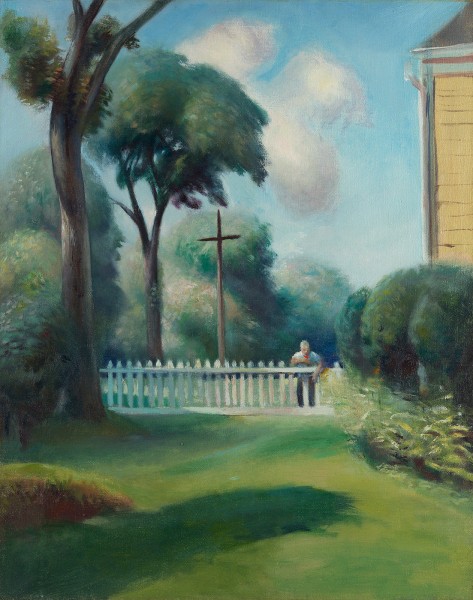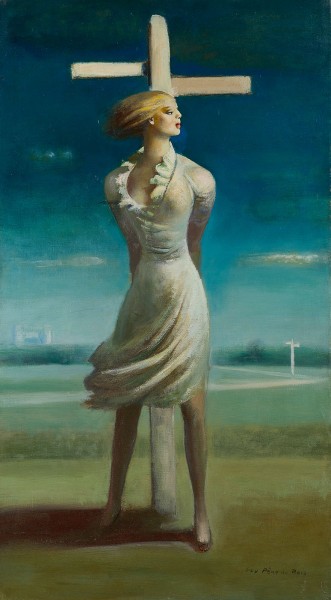Biography - National Gallery of Art
A cultural critic and artist throughout his life, Guy Pène du Bois was born in Brooklyn, New York. He studied from 1899 to 1905 with William Merritt Chase, Robert Henri, and Kenneth Hayes Miller. His earliest paintings were street scenes drawn in free brushstrokes and dark colors, reflecting Henri's influence.
After 1920 most of his work focused on middle- and upper-class people in fashionable restaurants and nightclubs, often portrayed in a satirical manner. The rounded, simplified figures of his subjects have been compared to mannequins or caricatures and convey Pène du Bois' critical attitude. Many of his images seem like quiet pauses in unfolding dramas, lending them an air of tension and mystery.
Pène du Bois' writing career developed along with his activities as an artist. He worked as a writer as well as a music and art critic for several New York newspapers. In 1913 he began a seven-year editorship of Arts and Decoration with a special issue on the Armory Show. The artist lived in France from 1924 to 1930. His autobiography, Artists Say the Silliest Things, was published in 1940. Pène du Bois died in 1958 in Boston, Massachusetts.
A twentieth-century American artist, art critic, and teacher whose work highlights human and social interaction in urban settings.Biography - Questroyal Fine Art, LLC, New York, New York
By Chelsea DeLay
I. Biography
II. Chronology
III. Collections
IV. Exhibitions
V. Suggested Resources
VI. Notes
I. Biography
Born in Brooklyn in 1884, Guy Pène du Bois was the son of Laura Hague and her husband, Henri Pène du Bois, a journalist with a penchant for French literature and culture. Henri decided to move his family to Staten Island when Pène du Bois was fourteen years old, and the next year the boy enrolled in the New York School of Art. He quickly developed a painterly technique and appreciation for Realism under his first instructor, William Merritt Chase. However, the notion of spending hours perfecting the academic method of painting was soon forgotten in the progressive classroom of legendary artist—and the New York School of Art’s newest instructor—Robert Henri.
When Henri began teaching life-drawing at the New York School of Art in 1903, his realist approach appealed to Pène du Bois and several of his classmates, including Edward Hopper, Gifford Beal, George Bellows, and Rockwell Kent.(1) Henri instructed his students to venture out of the studio and into the city to better understand the subjects they were to paint; this observational approach had a profound influence on Pène du Bois—an emphasis on the underlying social interaction between figures later became a characteristic trait of his work.
In 1905 Guy Pène du Bois and his father traveled to Europe, stopping briefly in London before finally settling in France. While in Paris, he briefly spent time studying at the Académie Colarossi and took private lessons from Théophile Steinlen.(2) The cafés, gardens, and opera houses offered Pène du Bois an inspiring glimpse at Parisian life that emerged as focal points in his early work.
As his style initially began to develop, Pène du Bois’s thinly-lined pen and ink drawings clearly incorporated the influence of several established French artists including Henri de Toulouse-Lautrec, Edgar Degas, and Honoré Daumier. His skill as a graphic artist demonstrated a considerable amount of promise—his early ability and talent garnered Pène du Bois an invitation to debut his work at the Paris Salon in 1905.
Pène du Bois’s time in France was cut short when his father fell ill in May of 1906 and, in an unfortunate turn of events, Henri Pène du Bois passed away while on the very ship returning him and his son to America. As a sentimental gesture honoring his father, he changed his signature from Guy du Bois to Guy Pène du Bois, a moniker used throughout the rest of his career.
After he arrived back in New York, Pène du Bois began working for the New York American and assumed a full-time position as an art critic in 1909. Writing for the New York American proved to be an indispensable career choice for Pène du Bois, who initially covered the police beat and regularly ventured downtown to the Jefferson Market Police Court to observe the interactions between lawyers, police officers, prostitutes, and criminals. The pieces inspired by the courtrooms demonstrate a shift in Pène du Bois’s style: his paintings were small in size, integrated darker colors and broader brushwork, and the faces and figures of his subjects adopted a rounded, stout shape, which became a distinctive silhouette typical of his figures.
Guy Pène du Bois married Florence “Floy” Sherman Duncan in 1911; the following year he left his position at the New York American and became a member of the Association of Painters and Sculptors.(3) 1913 was a busy year for Pène du Bois, both professionally and personally: he not only contributed work to the 1913 Armory Show, but also handled the show’s publicity and published a special edition of Arts and Decoration highlighting the exhibition.(4) That same year Pène du Bois welcomed the birth of his first child, daughter Yvonne, and also suffered the death of his mother, Laura Hague Pène du Bois.
At this point in his life, Pène du Bois had been juggling two careers: working as an artist and writing as an art critic. He wrote for several publications and his opinions as a critic were strengthened by his success as a practicing artist—Pène du Bois spent seven years as the editor of Arts and Decoration, two years at The New York Post, and also acted as an assistant to Royal Cortissoz at The New York Tribune.(5)
In 1913, Pène du Bois developed an artist-dealer relationship with Kraushaar Galleries in New York City and over the next few years his work was shown in exhibitions at the Corcoran Gallery of Art, Montross Gallery, the National Academy of Design, the Pennsylvania Academy of the Fine Arts, and the Whitney Studio Club. Pène du Bois’s increased efforts to focus on painting resulted in a style progression that began just before 1920 and his work began to consistently feature several distinct characteristics: larger canvases featuring members of urban society, flattened and abstracted figures, and entire scenes emanating a satirical sentiment that bordered on the line of disdain—all which became a tell-tale stylistic traits of his paintings.(6)
Pène du Bois decided to reconnect full-time with painting and moved his family to New Jersey in 1914—only to return to New York City three years later—and then to France in 1924.
Taking up residence in Garnes, a French town north of Paris, Pène du Bois found that the modernist trend in the art world left little room for his realist approach. He became plagued with financial troubles and a lack of inspiration, which led the funding from John Francis Kraushaar to be consequently cut off in 1930.(7)
In need of money, Pène du Bois returned to New York the next year and resumed writing to make ends meet, publishing monographs on artists Edward Hopper, William Glackens, and John Sloan. He also founded an eponymous art school in 1932, which unfortunately closed in 1950 due to low enrollment.
During the late thirties, Pène du Bois received several post office mural commissions, including Saratoga in the Racing Season in Saratoga Springs, New York and John Jay at His Home in Rye, New York. In 1940, his autobiography Artists Say the Silliest Things was published and he also was elected a Life Member of the Lotos Club and full Academician to the National Academy of Design.
One year after the death of longtime friend and dealer John Kraushaar in 1946, Pène du Bois and Kraushaar Galleries officially ended their artist-dealer relationship. Pène du Bois was hospitalized in 1949 when it was discovered that he had cancer, and his wife, Florence, passed away from a stroke in 1950. The death of his wife took a toll on Pène du Bois, but he was eventually drawn out of his depression in 1953 when Edward Hopper and Isabel Bishop encouraged him to become involved in Reality: A Journal of Artists’ Opinions. Pène du Bois returned from a brief trip to Paris with his daughter in 1956, and passed away at her home in Boston in 1958.
II. Chronology
1884 Born in Brooklyn, New York
1898 Henri Pène du Bois moves the entire family to Staten Island
1899 Enrolls in the New York School of Art, where his first teacher is William Merritt Chase
1902–03 Robert Henri begins teaching at the New York School of Art; his influence is evident in Pène du Bois’s bolder compositions
1905 Travels to Europe with his father, who was sent by the New York American to review exhibitions; briefly enrolls in Académie Colarossi and takes private lessons from Théophile Steinlen
1906 Decides to return stateside after his father falls ill in May, but Henri Pène du Bois passes away while en route to New York; after his father’s death, Pène du Bois changes his artist signature from Guy du Bois to Guy Pène du Bois
1909 Becomes a full-time art critic writing for the New York American
1910 Member of the hanging committee for the 1910 Exhibition of Independent Artists in New York
1911 Marries Florence Sherman Duncan
1912 Leaves New York American
Joins the Association of American Painters and Sculptors
1913 Daughter Yvonne is born
Works as Royal Cortissoz’s assistant at the New York Tribune
1913–15 Hired by Arts and Decoration; promoted to editor in 1913
1916 Son William is born
1916–18 Writes for New York Post
1917–21 Returns as editor of Arts and Decoration
1920–24 Teaches at the Art Students League, students include Alexander Calder and Isabel Bishop
1922 First solo exhibition at Kraushaar Galleries in New York City
1924 Decides to give up teaching and writing, moves to France to pursue painting full-time
1932–50 Opens the Guy Pène du Bois School; holds classes at his New York studio and in Connecticut
1937 Elected Associate member to the National Academy of Design
Completes first commission, Saratoga in the Racing Season, a federal mural in the post office of Saratoga Springs, New York
Receives mural commission for the post office in Rye, New York, completes John Jay at His Home in December
1938–39 Teaches during the summer at the Amagansett Art School on Long Island
1940 Publishes an autobiography entitled Artists Say the Silliest Things
Elected Academician to the National Academy of Design
1942 Completes mural for the Weymouth Branch of the Boston post office
1949 Hospitalized, receives cancer diagnosis
1950 Florence du Bois passes away
1953 Begins writing for Reality: A Journal of Artists’ Opinions after encouragement from Edward Hopper and Isobel Bishop
1953–56 Briefly moves to Paris with daughter Yvonne
1955 Agrees to be listed as one of the fifty-five initiating sponsors for the Independent Citizens’ Committee of the Arts, Sciences, and Professions
1958 Passes away at his daughter’s house in Boston
III. Collections
Academy Art Museum, MD
Addison Gallery of American Art, MA
Art Institute of Chicago, IL
Boca Raton Museum of Art, FL
Boston Museum of Fine Arts, MA
The Brooklyn Museum of Art, NY
Butler Institute of American Art, OH
Carnegie Institute, PA
Chrysler Museum of Art, VA
The Columbus Museum of Art, OH
The Columbus Museum of Art, GA
Crocker Art Museum, CA
Dallas Museum of Art, TX
Detroit Institute of Arts, OH
Indianapolis Museum of Art, IN
Los Angeles County Museum of Art, CA
Memorial Art Gallery, NY
Metropolitan Museum of Art, NY
Milwaukee Art Institute, WI
Montgomery Museum of Fine Arts, AL
Museum of Fine Art | Fort Lauderdale, FL
National Gallery of Art, Washington, D.C.
Neuberger Museum of Art, NY
Pennsylvania Academy of the Fine Arts, PA
Phillips Collection, Washington, D.C.
Rhode Island School of Design Museum of Art, RI
San Diego Museum of Art, CA
Sara Roby Foundation Collection, Washington, D.C.
Sheldon Museum of Art, NE
Smith College Museum of Art, MA
Smithsonian Museum of American Art, Washington, D.C.
Snite Museum of Art–University of Notre Dame, IN
Staten Island Museum, NY
Toledo Museum of Art, OH
United States Post Office, Saratoga Springs, NY; mural
United States Post Office, Rye, NY; mural
Whitney Museum of American Art, NY
IV. Exhibitions
1905 Paris Salon
1906, 1917–1949 Pennsylvania Academy of the Fine Arts, PA
1907 Gallery of the New York School of Art, NY
1908 Inaugural Exhibition of Independent Artists, NY
1910 Exhibition of Independent Artists, NY
1913 The Armory Show, NY
1915 Panama-Pacific International Exposition, CA
1914–57 Corcoran Gallery, Washington, D.C.; Clark Prize, 1937
1917, 1918 Whitney Studio, NY; solo exhibition, 1918
1919 Newport Art Association, RI; solo exhibition
1922, 1924, 1925, 1927–30, 1932, 1935, 1936, 1938, 1942, 1943, 1946 Kraushaar Galleries, NY; solo exhibitions
1927–50 National Academy of Design, NY; Second Altman Prize, 1936; First Altman Prize, 1945
1930 Art Institute of Chicago, IL; Norman Wait Harris prize
1939 Carnegie Institute, PA
Corcoran Gallery of Art, Washington, D.C.
1940 Washington County Museum of Fine Arts, MD
Mint Museum of Art, NC
Museum of Arts and Sciences, VA
1942 Museum of Fine Arts, Boston, MA; Maynard Prize
1944 Mystic Art Association, CT
1946 Century Association, NY; Robert Henri and Five of His Pupils
1954 Staten Island Museum, NY
1961, 1970, 1979, 1983, 1998, 2004 James Graham & Sons, NY
V. Suggested Resources
Baker, John. “Guy Pène du Bois on Realism,” The Archives of American Art Journal 17, no. 5 (1977): 2– 13. http://www.jstor.org/stable/1557177.
Cortissoz, Royal. “Guy Pène du Bois.” In American Artist Series. New York: Whitney Museum of American Art, 1931.
Falk, Peter H. “Guy Pène du Bois.” In Who Was Who in American Art, p. 969. Madison, Connecticut: Sound View Press, 1999.
Falman, Betsy. Guy Pène du Bois: Painter of Modern Life. New York: James Graham & Sons, Inc., 2004.
Péne du Bois, Guy. Artists Say the Silliest Things. New York: American Artists Group, 1940.
VI. Notes
1. Valerie Ann Leeds, The Independents: The Ashcan School & Their Circle from Florida Collections (Winter Park, FL: Rollins College, 1996), 20.
2. Betsy Falman, Guy Pène du Bois: Painter of Modern Life (New York: James Graham & Sons, Inc., 2004), 13.
3. Peter H. Falk, “Guy Pène du Bois,” in Who Was Who in American Art (Madison, Connecticut: Sound View Press, 1999), 969.
4. John Baker, “Guy Pène du Bois on Realism,” The Archives of American Art Journal 17, no. 5 (1977): 2. http://www.jstor.org/stable/1557177.
5. Ibid.
6. Falman 25.
7. Ibid, 39.
AUCTIONS
Bonhams 2014
GUY PÈNE DU BOIS(American, 1884-1958)Fly Fisherman20 x 16inUS$ 12,000 - 18,000
£7,600 - 11,000Sotheby's 2014GUY PÈNE DU BOISPROMENADE
LOT SOLD. 5,000 USDSotheby's 2013GUY PÈNE DU BOIS
1884-1958SPEAKEASY
LOT SOLD. 365,000Sotheby's 2012GUY PÈNE DU BOIS
1884-1958CAFÉ DÔME
LOT SOLD. 242,500 USD
GUY PÈNE DU BOIS
1884-1958CROQUET PLAYERS, LUXEMBOURG GARDENSEstimate 50,000 — 70,000
Christie'sThird Avenue ElPRICE REALIZED$782,500Place Massena, NicePRICE REALIZED$290,500Social RegisterPRICE REALIZED$194,500Bull Market PromenadePRICE REALIZED$158,500At the Met (The Old Met)PRICE REALIZED$122,500Old Styles and NewPRICE REALIZED$75,000Summer Day, Old Manor FarmPRICE REALIZED$15,000Christie's 2014Christie's 2013
Chrstie's 2009
Chrstie's 2005
Christie’s 2004
Christie’s
Chrsitie's 2001
Christie's 2000
Swann 2005
GUY PÈNE DU BOISTwo Young WomenEstimate $12,000 - $18,000Price Realized (with Buyer's Premium) $11,500
- GUY PÈNE DU BOISCountry Fair with HorsesEstimate $4,000 - $6,000Price Realized (with Buyer's Premium) $10,350
Skinner 2009
National Gallery of Art
-
- Pène du Bois, Guy
- , American, 1884 - 1958
- The Politicians
- c. 1912
- oil on fabric-covered millboard
- overall: 40.6 x 30.7 cm (16 x 12 1/16 in.)
- framed: 56.5 x 46.4 x 5.7 cm (22 1/4 x 18 1/4 x 2 1/4 in.)
- Chester Dale Collection
- 1963.10.138
-
- Pène du Bois, Guy
- , American, 1884 - 1958
- Hallway, Italian Restaurant
- 1922
- oil on canvas
- overall: 64 x 51 cm (25 3/16 x 20 1/16 in.)
- framed: 80.7 x 68 x 3.2 cm (31 3/4 x 26 3/4 x 1 1/4 in.)
- Chester Dale Collection
- 1963.10.137
-
- Pène du Bois, Guy
- , American, 1884 - 1958
- Café du Dôme
- 1925/1926
- oil on wood
- overall: 55.2 x 46 cm (21 3/4 x 18 1/8 in.)
- framed: 66 x 56.8 x 2.9 cm (26 x 22 3/8 x 1 1/8 in.)
- Chester Dale Collection
- 1963.10.136
-
- Pène du Bois, Guy
- , American, 1884 - 1958
- La Rue de la Santé
- 1928
- oil on canvas
- overall: 92 x 73.3 cm (36 1/4 x 28 7/8 in.)
- framed: 100.3 x 81.9 cm (39 1/2 x 32 1/4 in.)
- Chester Dale Collection
- 1963.10.139
Questroyal Fine Art, LLC, New York, New York
Guy Pène du Bois (1884–1958)
Backyard
Oil on canvas
22 1/16 x 18 inches
Guy Pène du Bois (1884–1958)
The Ballet Tryout
Oil on canvas
40 x 30 inches
Signed lower left: Guy Pène du Bois
Guy Pène du Bois (1884–1958)
Crossroads
Oil on canvas
36 1/16 x 20 1/16 inches
Signed lower right: Guy Pène du Bois
Menconi + Schoelkopf
Guy Pene du Bois
Lawyers, c. 1945
Oil on paper mounted on canvas
24 x 17 9/16 inches
61 x 44.6 cm
In writing about Pene du Bois’s later paintings, Betsy Fahlman observed: Some of Pene du Bois’s strongest works from the forties are part of a series of remarkable courtroom scenes. Loose in style and infused with mysterious colors, they continue the exploration of a type he began decades earlier, when he was a police reporter [Guy Pene du Bois: Painter of Modern Life (New York: 2004), p. 62].
Bernard Goldberg Fine Arts
Guy Pene Du Bois
Teddy at the Typewriter, 1932
Oil on canvas
25 x 20 inches
Signed and dated: Guy Pene Du Bois ‘32
